
Harvesting, Cooking, And Then Eating A Dahlia Tuber
Hello friends,
Yes, I finally did it. I finally had the opportunity to try harvesting, cooking, and then eating one of my dahlia tubers.
I've been growing dahlias from seed this year as part of my dahlia breeding program, and a lot of the dahlias that flower just don't have the characteristics I'm looking for in a great seedling. Either they're single dahlias, or they have very plain and boring colours, or their flower heads are weak (and they droop), so I pull them out of the ground once I'm sure I know what sort of dahlia they are like.

I plant my dahlia seedlings very close together for spacing reasons, and when I decide that a dahlia is not what I'm looking for, that's when the dahlia seedling is pulled out of the ground, giving more space for other dahlia seedlings to grow in the garden bed.
All ornamental dahlias are edible, particularly the tubers, and their taste apparently is reminiscent of a potato crossed with celery, depending on which dahlia variety you harvest and cook. Dahlia tubers contain inulin (a prebiotic carbohydrate), other carbohydrates, have four times the amount of potassium than bananas have, and are high in fiber, making them a great food source if needed (Dahlia nutrition information (Nsabimana and Bo Jiang 2011).

With all this in mind, the next time I had to remove an unwanted dahlia seedling, I decided it was the time to try cooking and then eating a dahlia myself. The seedling dahlia donating its tubers was Dahlia SR 11, a boring single apricot dahlia variety that had flowered a few times, but its flower hadn't improved at all...

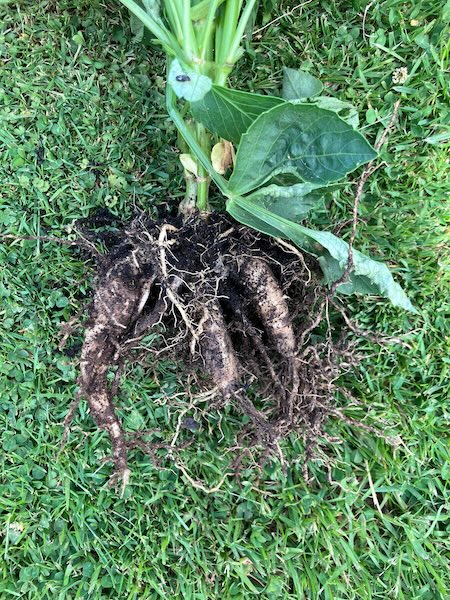
I dug the dahlia out of the ground, removed the stems and leaves, and then washed out as much dirt as possible from the tubers and roots. After bringing the root system of the dahlia into our kitchen, I cut off the small tubers the dahlia seedling had begun to grow. Small dahlia tubers we thought would be less fibrous, and more easy to cook with, compared to older and bigger tubers.

After giving the tubers another wash to remove all the dirt, I peeled the dahlia tubers as was suggested on the internet by other sources. With them now clean, I put the tubers into a small pot containing water, and added a bit of salt (similar to when boiling potatoes).

We brought the pot of water up to a boil, and let the dahlia tubers simmer for 10 minutes. At that point we tested the tubers with a knife and found them to be al dente, which was what my research suggested meant that the dahlia tubers were ready for eating. We cut one of the dahlia tubers up into thin slices and ate the slice plain...

The dahlia tuber was okay to eat, and did indeed taste like a potato crossed with celery (and it was a little earthy tasting too, a bit like beetroot). A bit plain, but okay. We sprinkled a little salt on top of the dahlia tuber slices, and it definitely improved the taste.

Wanting to explore eating the dahlia tubers further, we decided to pan fry the rest of the cooked and sliced tubers, to try out other flavor combinations with them, using ingredients we already had in the kitchen...
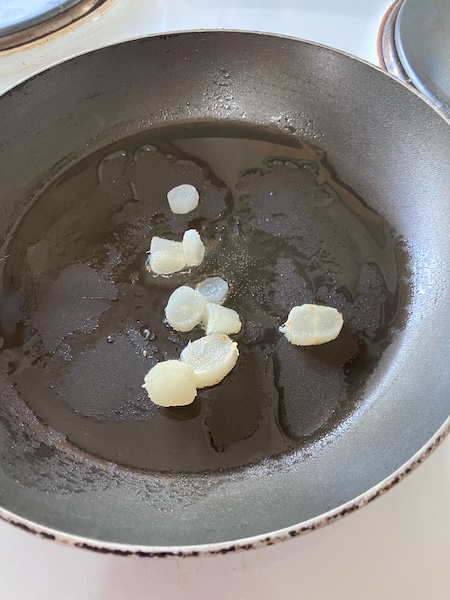
Here are the dahlia tuber flavor combinations we tried:
- Chilli and Garlic - Definitely more tasty than plain, the flavor was improved by sprinkling a tiny bit of salt on top to finish.
- Parmesan and Salt - Super tasty when fried plain and then sprinkled with parmesan and salt at the end.
- Basil and Olive Oil and Salt - Quite pleasant, but not as nice as the Parmesan and Salt.
- Fried in Butter with Chilli and Lemon Juice and Garlic - Definitely my favorite. The chilli and lemon and garlic combination made the dahlia tuber super tasty. We think it would've been better with lime juice instead of lemon, but we didn't have any available at the time.

With all those flavor combinations completed, we were out of dahlia tubers to eat, and that was perfectly okay for ending our experiment in dahlia cooking and eating.
I think that doing this experiment in dahlia cooking and eating was a good experience to try once. It was okay to eat, but if it came to a choice between eating potatoes and eating dahlia tubers, potatoes would be my choice every single time. If it ever came to a point that there was no choice but to eat dahlia tubers to survive (like during a zombie apocalypse), I would very happily do it, as long as I didn't need to eat any of my precious named dahlia varieties to do so. Those are sacrosanct, but they would make great seed producing dahlias, and those seeds could then go onto produce seedling dahlias tubers which I would happily to eat in the long term...
Have a wonderful day
Julie-Ann
Want to discuss my post? Feel free to chat with me on Instagram or Mastodon or Bluesky, and now also Facebook.
Floret Flower Farming Online Workshop 2026
Hello friends,
By the time you've read this blog post, I will have already been studying for one week in the 6 week online Floret Flower Farming Workshop.
Every year in October, Floret Flower Farm opens registrations for their yearly online Floret Flower Farming Workshop. It's an in depth 6 week workshop covering all things flower farming: including whether flower farming is right for you (and what you might want it to look like), planning and mapping out your flower farming operation, making a start at flower farming, growing your flowers, sales and marketing, and finally harvesting cut flowers and selling them in whichever way works for you.
Their online workshop has a massive course book, and hundreds of video lessons to go through, along with question and answer video sessions, and an online community for those learning together in the workshop.
I've wanted to do this workshop for many years, and when registrations opened last October, hubby encouraged me to register and finally fulfill my dream to study with Floret. After registering, it wasn't long before a heavy package arrived in the mail from Floret, containing the course book and other workshop goodies.

I spent a long time flicking through the pages of the workshop course book, getting excited for the workshop starting in early January 2026, and then in early December it was time for workshop orientation. There were some online videos to watch about what was to happen in the workshop, along with some administration tasks to accomplish ahead of the starting date. One exciting part was a trip to a stationery store to buy workshop supplies including a poster board, graph paper and tracing paper, and a new A4 binder to hold all the worksheets I would be downloading and filling out...

And now it's January, and the Floret Flower Farming Workshop has begun. I'll be super busy with the workshop for the next 5 weeks, but I already have enough blog posts lined up to cover this period (hopefully, if everything goes to plan...).
Have a wonderful day
Julie-Ann
Want to discuss my post? Feel free to chat with me on Instagram or Mastodon or Bluesky, and now also Facebook.
A New Bullet Journal for a New Year
Hello friends,
And welcome back to 2026 on the blog...
A new year usually means a fresh new start, and it was quite lucky for me that my current Leuchtturm 1917 notebook containing my weekly Bullet Journal (BUJO) spreads was due to finish at the end of 2025. This not only gave me an opportunity to buy a new Leuchtturm 1917 dotted notebook (in the colour Dusty Rose), but it also meant I could decorate it with a bunch of new stickers, with this notebook's theme being "witchy".
After carefully looking through my embarrassingly large sticker collection, I found some stickers which fit the theme, and placed them strategically on the front and back of the notebook's covers.



With that done, it was time to decorate the front section of the notebook, before starting on the first weekly spread of the year.


I've tried many different bullet journal set ups over the years, but this weekly set up works the best for me in terms of seeing the week as a whole, and to make sure I accomplish all my tasks for the Crafty Gardener blog, my small business Hearth and Oak, and for my upcoming 6 week online flower farming workshop with Floret Flower Farm.



On the left hand page are my weekly goals, weekly habit tracker, and general to do list (remembering things like upcoming birthdays, specific household tasks, and also to book vet appointments etc).

On the right hand side are the days of the week, showing appointments, boring stuff like putting out the rubbish, cleaning and washing, and also tasks to do each day. I like using the SMART goal framework, with goals being specific, measurable, achievable, relevant, and timely. It means I actually get tasks done, and not procrastinate.

With everything written in for the coming week, my first weekly BUJO spread was ready for the first day back at work for 2026. Not a fun thing to think about after two weeks on holiday, but at least I had a head start for the coming year first thing on Monday morning...
Have a wonderful day
Julie-Ann
Want to discuss my post? Feel free to chat with me on Instagram or Mastodon or Bluesky, and now also Facebook.
New Roses Flowering In The Garden
Hello friends,
And welcome to the last blog post of the year. Today I thought I'd share with you the new rose bush varieties flowering in the garden at the moment, that I've been waiting impatiently to flower ever since I planted them last winter (and even early this month in one case...).
First up we have my new 'Cuppa Tea' floribunda rose bred in New Zealand by Bob Matthews, from his popular for picking rose 'Cappuccino'.
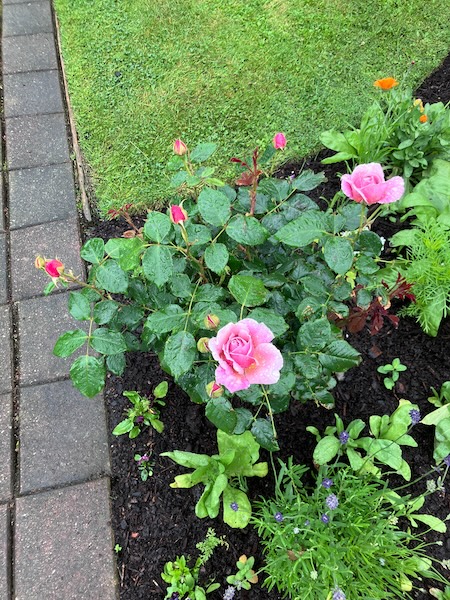
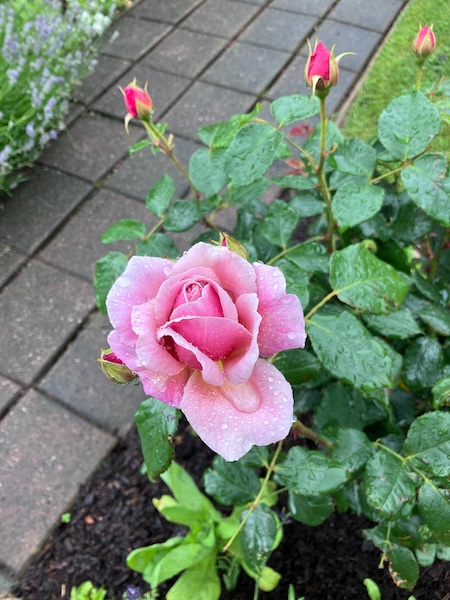
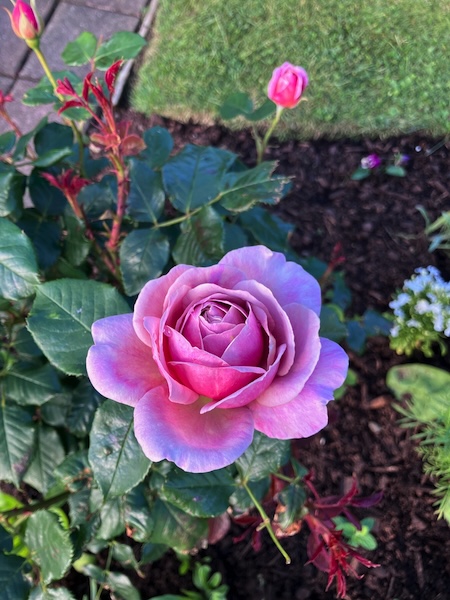
I'm so pleased to have purchased this new rose variety this past winter, the muted pink/purple/bronze shading is just so stunning, and is unlike any other rose colour I've ever seen. I can't wait for her to be covered in flowers all throughout the summer.
Next up we have my new climbing rose Azubis. This is the second Azubis rose bush that I have bought this year, the original one was wind blasted during the big North Westerly storm we had in October, and then it slowly died over the weeks afterward, no matter how hard I tried to save it. Luckily, the garden center I purchased it from had one Azubis bush remaining in late October, so I picked it up and planted it straight away into a more sheltered part of the garden. Azubis is a beautiful climber, producing large lilac blue blooms with a huge fragrance.

My Azubis rose bush may be very small at the moment, but she has already flowered once, and her single lilac bloom is huge and smells like heaven. I can't wait for her to grow up and cover our back garden fence in years to come.
And finally we have my newest rose, Chawton Cottage, another climbing rose, bred in England by Harkness Roses, and named for Jane Austen’s House which is now a museum. Chawton Cottage has sensational pearl pink blooms with a distinctive raspberry purple eye. These unique flower clusters are delicately fragrant and fantastic for picking.

I was walking through our local Mitre 10 when Chawton Cottage caught my eye. She was flowering with multiple blooms in early December. Her unusual single flowers with a pearl pink outer flower and a deep raspberry inner, was just stunning, and bees swarmed around her. Before you could blink an eye, I had Chawton Cottage in my arms, and handed over my debit card to the cashier.
I bought her home and wandered around the garden with her until I found the perfect spot for her, up against our trellis fence at the end of the driveway.

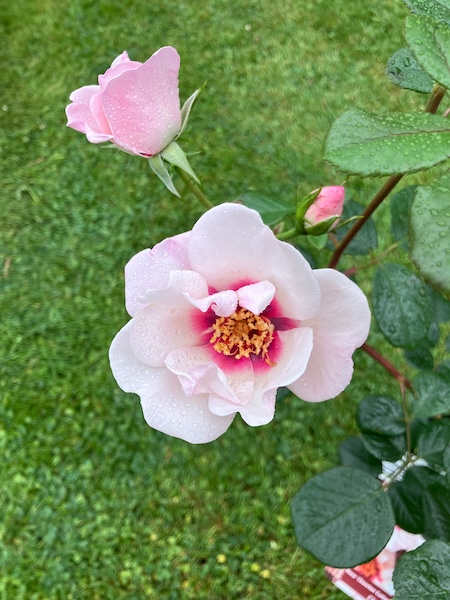
I had to do some pruning to get her to fit up against the trellis, and over the coming years I will trail her along and up the fence line to produce a wall of flowers at the end of the driveway.
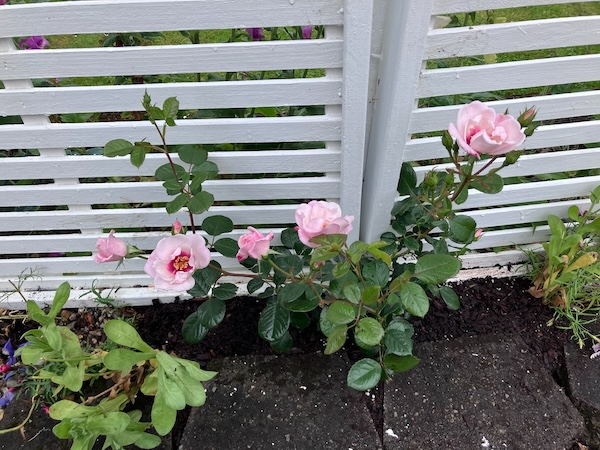
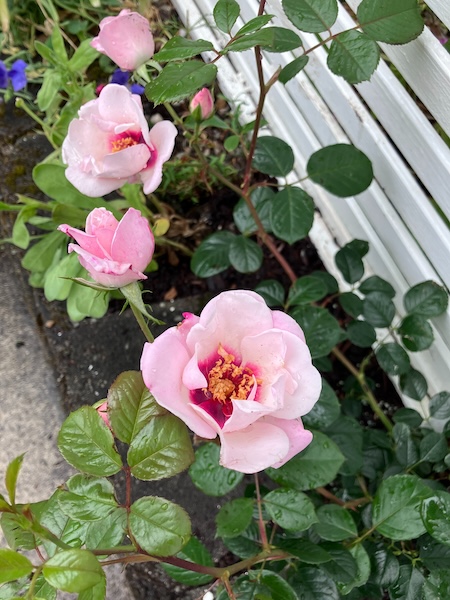

She just looks so pretty in pearl pink and green and raspberry up against the trellis, adding a lot of joy to a space that has been difficult to garden in over the years.
I hope you enjoyed a look at my new flowering rose varieties from this year. And I hope you have a wonderful Christmas and New Year period, and I'll see you again soon in January 2026...
Have a wonderful day
Julie-Ann
Want to discuss my post? Feel free to chat with me on Instagram or Mastodon or Bluesky, and now also Facebook.




